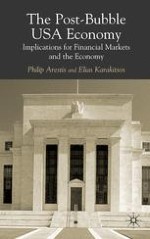2004 | OriginalPaper | Chapter
The US External Imbalance and the Dollar: A Long-term View
Authors : Philip Arestis, Elias Karakitsos
Published in: The Post-Bubble US Economy
Publisher: Palgrave Macmillan UK
Included in: Professional Book Archive
Activate our intelligent search to find suitable subject content or patents.
Select sections of text to find matching patents with Artificial Intelligence. powered by
Select sections of text to find additional relevant content using AI-assisted search. powered by
The finance of the huge US current account deficit has so far been met very easily, as the residents in the Rest of the World (ROW) have been willing to lend the US the necessary funds to cover this deficit. This process has turned the US into a serious net debtor to the ROW in the last twenty years. However, the debt is in US dollars and there are no immediate good reasons why residents in the ROW should lose their confidence in the ability of the US to service this debt. There is a risk, though, that ROW residents may lose their appetite to hold US assets, if they continue to suffer huge losses on their holdings of US assets. As we argued in Chapter 1 above, during September and October 2003 there was a temporary drop in the desire of foreign investors to accumulate US assets, but this was restored subsequently. The risk that foreigners may, at some point in time, lose their appetite implies that it would be better that the US should balance or, at least, reduce its current account deficit. The dollar is on declining trend and that would help the current account deficit, because the economy is operating with spare capacity and needs to boost its exports to foster the recovery.
